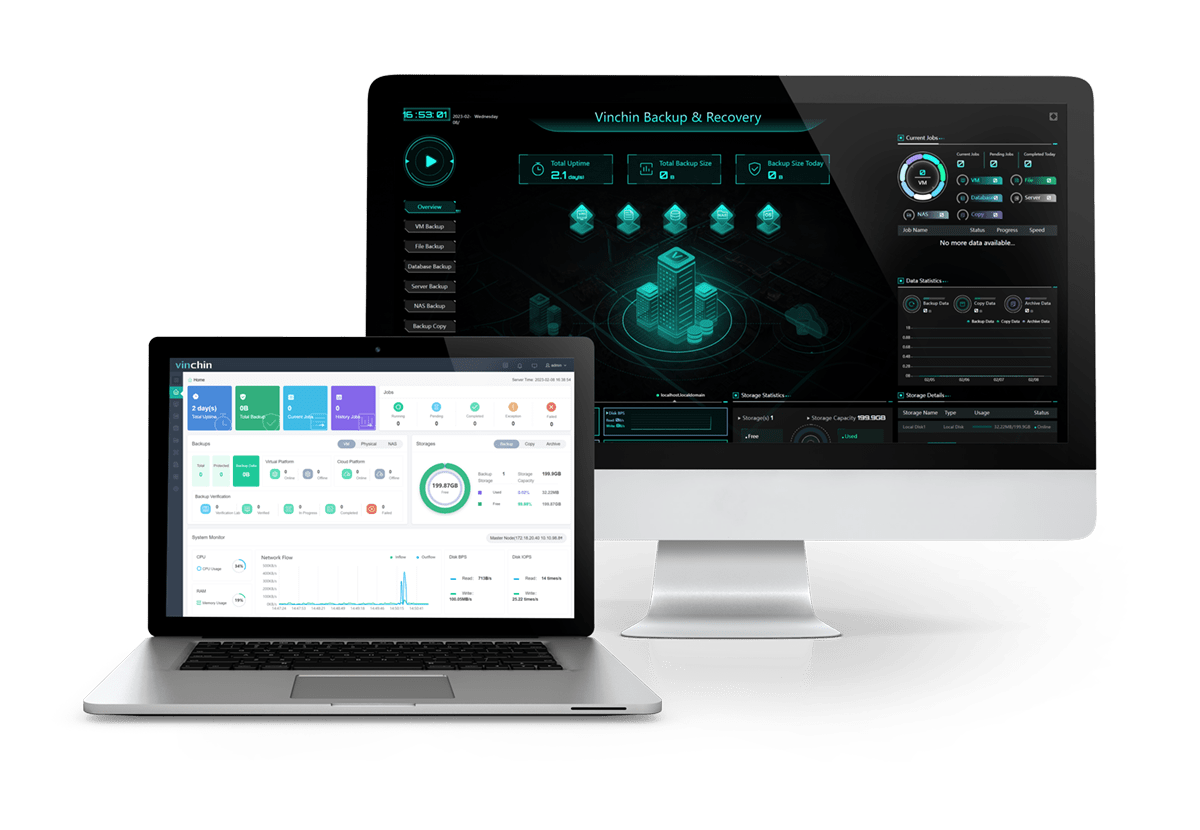-
What is IT infrastructure management?
-
How does IT infrastructure management work?
-
Why is IT infrastructure management important?
-
Challenges in IT infrastructure management without ITIM tools
-
How to monitor and manage IT infrastructure?
-
Protecting your IT virtualization environment
-
Conclusion
The IT infrastructure is a complex system comprising various physical infrastructure components such as firewalls, servers, switches, and load balancers, along with virtual infrastructure components like Xen, VMWare, Nutanix, Hyper-V, and applications. As the complexity of IT infrastructure continues to grow at an unprecedented pace, IT administrators are engaged in an ongoing battle to ensure the efficiency and up-to-date state of their networks.
What is IT infrastructure management?
IT infrastructure management is the process of overseeing all the hardware, software, and network components involved in the IT infrastructure to improve monitoring efficiency, reduce costs, and deliver business solutions effectively.
How does IT infrastructure management work?
IT infrastructure management involves tracking key network endpoints such as routers, switches, firewalls, servers, and other critical parameters to ensure proper performance, bandwidth utilization, configuration management, IP and switch port management, and firewall security. It involves managing them to ensure organizations achieve the maximum return on investment in their IT infrastructure.
Why is IT infrastructure management important?
Monitoring and managing every device in the IT infrastructure is crucial because problems occurring in a single network device can impact the efficiency and performance of the entire IT infrastructure, thereby affecting the business. Hence, IT infrastructure management is crucial as it helps technical personnel take proactive measures to enhance performance and uptime.
Challenges in IT infrastructure management without ITIM tools
Challenges in monitoring availability and operational status
IT infrastructure management begins with ensuring the availability and operational status of all devices and interfaces connected to the network. To avoid any unexpected issues, it is essential to ensure 24/7 monitoring of critical business devices.
Challenges in performance, processes, and service levels
Monitoring performance metrics of IT infrastructure requires an organized approach. Managing the heterogeneity of vendors is crucial to determine factors for performance monitoring, such as CPU and memory utilization, packet drops, temperature, fan speed, and other performance indicators, to enhance efficiency. After considering the criticality of monitoring parameters and the importance of devices, certain devices and their parameters can be prioritized.
The efficiency of IT infrastructure depends on its ability to deliver business solutions. Besides device availability, service and process availability also play a vital role. If ITIM services or processes stop functioning, it may directly or indirectly impact the delivery of business solutions, resulting in business losses. Therefore, in addition to device performance, equal attention must be given to monitoring various processes and services running on the devices.
Configuration management challenges
Configuration changes in the infrastructure should only follow role-based approvals. Each time a configuration change is pushed to a device, there is a potential risk of errors and device downtime. There are several factors that can contribute to such situations, such as configuration mistakes, poor deployment of configuration parameter changes, and conflicts in configuration values.
Human errors in configuration, especially during critical processes like firmware upgrades, can bring the entire network to a halt. Administrators not only need to ensure disaster recovery backups are in place as a fail-safe option but also track and maintain detailed reports regarding the configuration changes implemented on infrastructure devices.
Bandwidth optimization challenges
The bandwidth of each network is limited, and the administrator’s task is to ensure sufficient bandwidth allocation for all critical business applications. The administrator should also analyze the bandwidth consumption of individual users to ensure that individual devices do not exceed their allocated bandwidth. This will help the administrator gain a better understanding of network traffic patterns and enable the formation of effective bandwidth utilization rules.
Compliance implementation challenges
As the scale of the enterprise expands, the number of devices in the network also increases, which correlates with the effort required to ensure infrastructure compliance with various industry-specific policies (SOX, HIPAA, PCI DSS, SANS, etc.). It is crucial to ensure that all devices adhere to the required protocols to maintain compliance.
Infrastructure security challenges
In terms of IT infrastructure security, administrators must ensure that firewalls adhere to the latest standards, perform log analysis to identify security threats, monitor internet usage by supervising virtual private networks (VPNs) and proxy users, and more. Only by establishing sound security rules can your firewall infrastructure effectively fulfill its role.
IP address management challenges
When adding new devices to IT infrastructure, it is essential to ensure that no two devices share the same IP address. Close monitoring of allocated IP addresses enables administrators to quickly assign unused IP addresses to new devices and prevent IP conflicts. Additionally, administrators must restrict network access for devices with rogue IP addresses, as they pose a security risk.
Integration challenges
IT infrastructure management solutions should not be limited to simply monitoring devices and receiving alerts on time. It is crucial to address faults identified through alerts promptly. So, integration plays a vital role in this process. Integration is used to enhance the functionality and monitoring capabilities of IT infrastructure management tools. Choosing tools that integrate with appropriate third-party solutions( such as ITSM tools, communication tools, and alert management tools) greatly improves the overall efficiency of network operations.
Storage management challenges
The amount of data storage required by enterprises is rapidly growing, accompanied by an urgent need for storage monitoring. Storage management tasks include identifying growth trends, monitoring capacity utilization, and ensuring that your enterprise never runs out of storage space.
How to monitor and manage IT infrastructure?
IT infrastructure management can be divided into the following six components:
1. Categorization of physical and virtual devices:
Continuously categorizing and monitoring physical and virtual devices helps easily identify any lag in performance, errors, or faults. This aids in optimizing the performance of physical devices such as servers, routers, as well as virtual devices like Vmware, Nutanix, and Hyper-V.
2. Determination of key performance indicators (KPIs):
Each device belongs to different categories in terms of criticality and its associated indicators. To effectively manage IT infrastructure, identifying the key indicators for each device and appropriately focusing on them is crucial.
3. Visualization:
Thorough visibility of the entire IT infrastructure helps technicians meticulously track performance and other key metrics. This facilitates proactive measures to eliminate device failures or downtime.
4. Monitoring and alerts:
Continuous monitoring and proactively sending alerts to technicians in case of network failures safeguards devices against faults, which also greatly contributes to maintaining network stability.
5. Notifications:
Sending precise notifications to the appropriate teams through the right channels plays a vital role in building a resilient network that can withstand downtime. It greatly assists teams in addressing issues promptly.
6. Fault management:
Automating L1 and L2 basic network operation faults enables quick resolution, which can enhance device performance and significantly reduce mean time to repair (MTTR).
Protecting your IT virtualization environment
To better protect and manage your IT infrastructure, it is recommended to backup your virtual machines with a professional backup and disaster recovery solution.

Vinchin Backup & Recovery is a professional solution which supports data backup of VM like VMware vSphere, Hyper-V, XenServer, XCP-ng, oVirt, RHV, OpenStack, etc. and other data like database, NAS, file server, etc.
By using Vinchin Backup & Recovery, you can instantly recover the entire VM and all its data from any restore point (no matter it's a full backup, incremental backup or differential backup) without any effectings on the original backup data. It is an excellent solution to ensure business continuity, minimize the loss of crucial business interruption caused by disaster or system failure.
Besides, Vinchin Backup & Recovery can migrate VMs across 10+ virtual platforms including VMware, XenServer, and most KVM-based hypervisors. You can easily switch your critical modern IT workloads from one to another to build your own highly flexible IT infrastructure.
Vinchin Backup & Recovery has been selected by thousands of companies and you can also start to use this powerful system with a 60-day full-featured trial! Also, contact us and leave your needs, and then you will receive a solution according to your IT environment.
Conclusion
IT infrastructure management is vital for maintaining the efficiency and performance of an organization’s IT systems. It involves monitoring hardware, software, and network components, identifying key performance indicators, and managing faults. Despite the challenges of managing complex systems, effective tools and strategies can optimize performance, reduce costs, and enhance business solutions delivery.
To efficiently protect IT virtualization environment, you can choose Vinchin Backup & Recovery to easily backup and recover your VMs and critical data. Don’t miss the free trial.
Share on:








